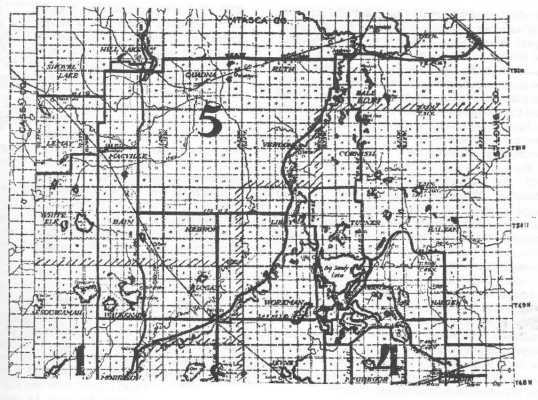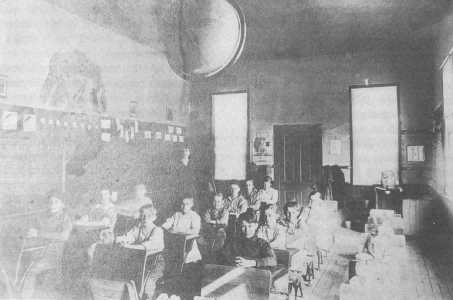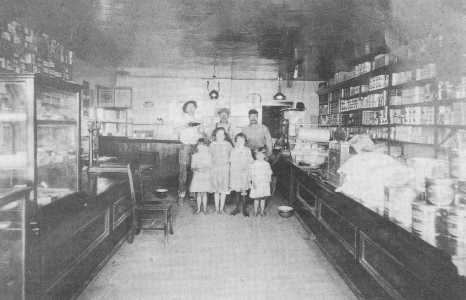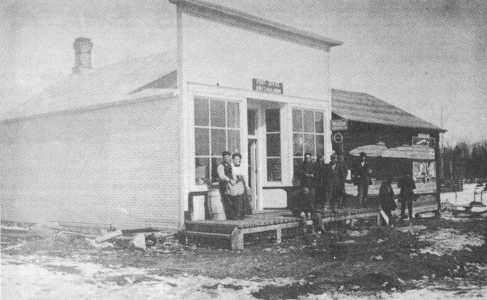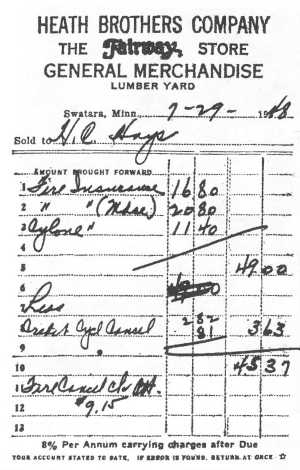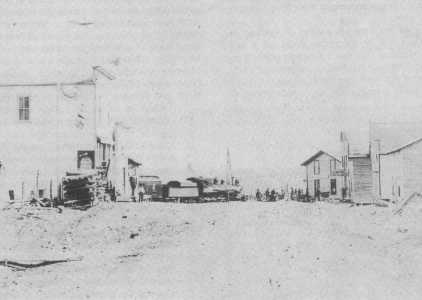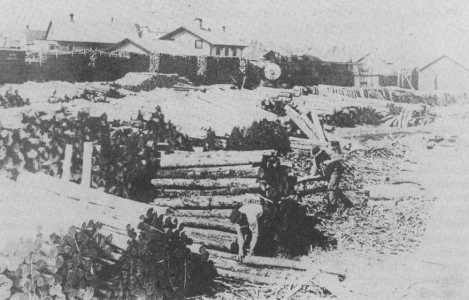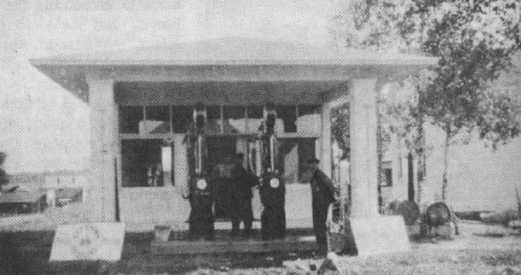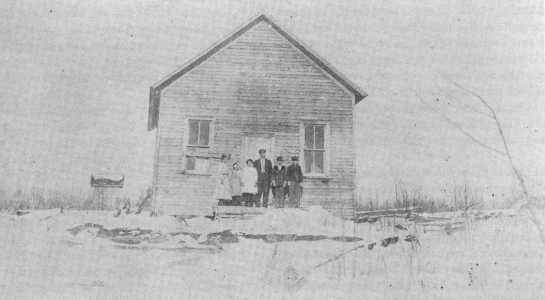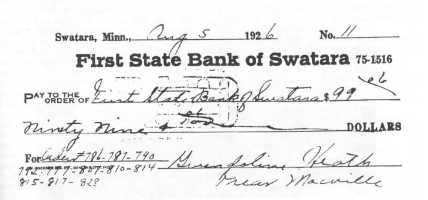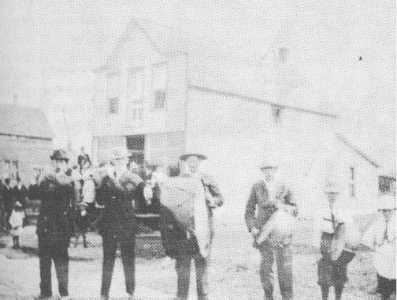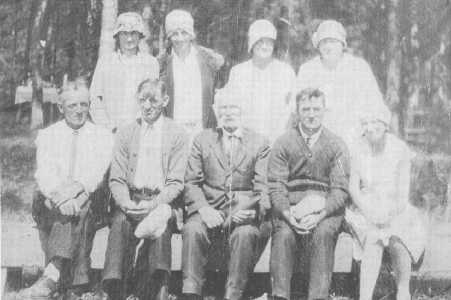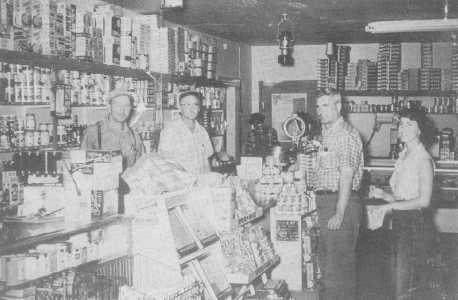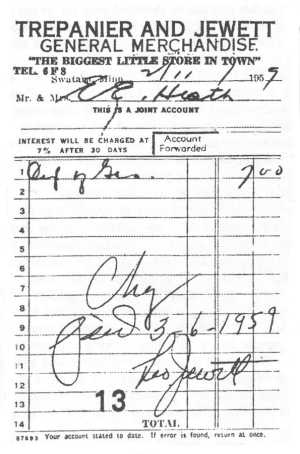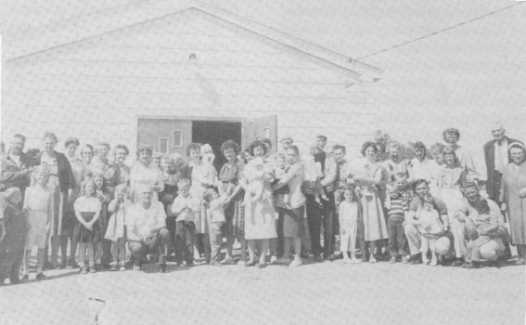



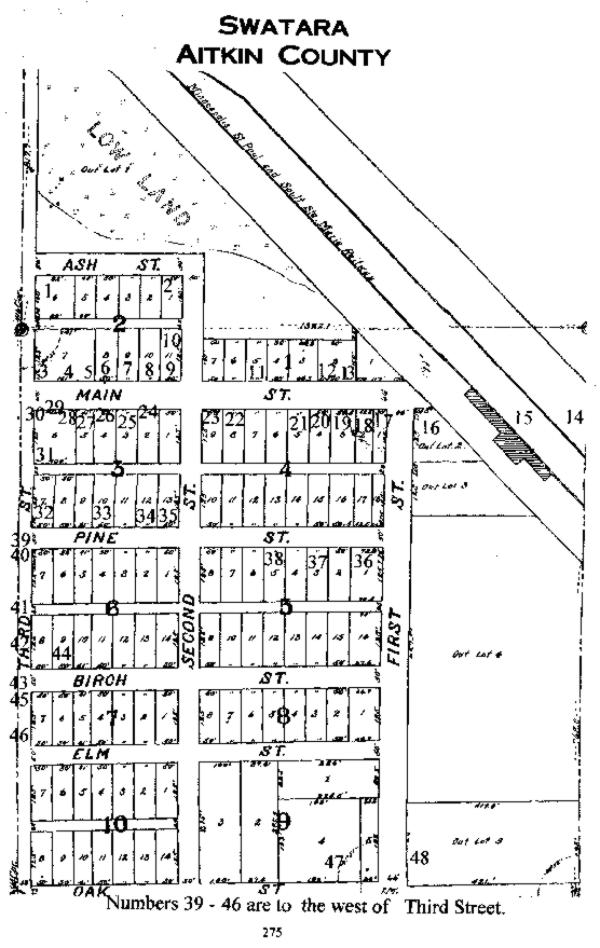

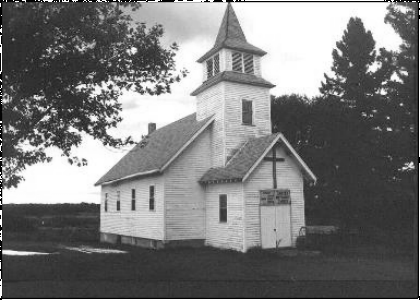
|
NAMES
|
DATES
|
NAMES
|
DATES
|
| Rev. Arthur Cartwright | 1925 to 1928 | Rev. Wallace Johnson | 1928 to 1930 |
| Rev. Elsie Hartman | 1930 to 1942 | Rev. Arthur Hoerauf | 1942 to 1946 |
| Rev. C. F. Paine | 1946 to 1947 | Rev. James Dowler | 1947 to 1948 |
| Rev. Robert Rowlin | 1948 to 1949 | Rev. Forest Pierce | 1949 to 1955 |
| Rev. R. J. Stokey | 1955 to 1957 | Rev. M. G. Kovalchik | 1958 to 1961 |
| Rev. James Dowler | 1961 to 1962 | Rev. James Baker | .1962 to 1963 |
| Rev. T. D. Brennan | 1963 to 1966 | Rev. John White | 1966 to 1973 |
|
Name |
Parents
|
Birth
|
Baptized
|
Minister
|
| Angermo, Ann Lucille | Conrad & Fannie | private | 12/3/1933 | Hartman |
| Arrowood, David | William & Silvia | 7-23-1925 | 4-4-1926 | Cartwright |
| Allain, Annabelle | Mr. & Mrs. Frank | not given | 4/13/1941 | Hartman |
| Arnold, Robin Jo | Gary & Joan | private | 6-2-1963 | Baker |
| Biskey, Kathleen Alice | Fred & Eunice | private | 5-14-1944 | Hoerauf |
| Biskey, Linda Sue | Fred & Eunice | private | 8-8-1948 | Dowler |
| Biskey, Robert Alan | Fred & Eunice | private | 4-13-1941 | Hartman |
| Biskey, Joanne | Fred & Eunice | private | 4-14-1935 | Hartman |
| Biskey, Gerald Lee | Fred & Eunice | private | 4-12-1936 | Hartman |
| Bailey, Dale Edward | Rodman & Karin | private | 1-2-1949 | Dowler |
| Bailey, Cheryl Rae | Rodman & Karin | private | 11-5-1950 | Dowler |
| Butterfield, Steven | Barbara | private | 3-29-1953 | Rollin |
| Butterfield, Lucille (Raines) | - | 2-14-1926 | 4-6-1955 | Rollins |
| Bartlett, Ruby Ellen | Mr. & Mrs. A | private | 4-13-1941 | Hartman |
| Bartlett, Cecilia | Mr. & Mrs. A | private | 4-13-1941 | Hartman |
| Bartlett, Allan Harold | Mr. & Mrs. A | private | 4-13-1941 | Hartman |
| Baty, Opal Jean | James & Della | private | 4-14-1935 | Hartman |
| Bailey, George Clifton | George & Lillian | private | 11-10-1935 | Hartman |
| Bailey, Mary Joan | George & Lillian | private | 5-9-1937 | Hartman |
| Boyd, Kathleen Grace | D.B. & Pearl | 9-18-1913 | 4-2O-1944 | Cartwright |
| Boyd, Zella Mae | D.B. & Pearl | 8-23-1914 | 4-20-1924 | Cartwright |
| Boyd, Charlotte | D.B. & Pearl | 1-30-1918 | 4-20-1924 | Cartwright |
| Biskey, Irene Lorraine | John & Alice | 11-12-1910 | 4-2O-1924 | Cartwright |
| Biskey, Alice Lucille | John & Alice | 1-19-1919 | 4-20-1924 | Cartwright |
| Biskey, Frederick Leon | John & Alice | 7-7-1914 | 4-20-1924 | Cartwright |
| Baldwin, Della Mae | - | 1-23-1904 | 4-20-1924 | Cartwright |
| Baldwin, Olive Carey | - | 1-26-1905 | 4-20-1924 | Cartwright |
| Baldwin, Charles P. | - | 2-9-1918 | 4-20-1924 | Cartwright |
| Baldwin, Noble F. | Harry & Minnie | 10-29-1918 | 4-20-1924 | Cartwright |
| Biskey, John | - | - | 4-12-1925 | Cartwright |
| Biskey, Alice | - | 1-6-1892 | 4-12-1925 | Cartwright |
| Baldwin, Mrs. Minnie | - | - | 4-12-1925 | Cartwright |
| Bowers, Jeanette | - | - | 4-12-1925 | Cartwright |
| Bowers, Charlotte | - | - | 4-12-1925 | Cartwright |
| Baty, Glen | - | - | 4-12-1925 | Cartwright |
| Becker, Charles | - | - | 4-12-1925 | Cartwright |
| Biskey, Bessie Luella | John & Alice | 9-5-1926 | 4-17-1926 | Cartwright |
| Baty, Herbert Richmond | Glen & Della | 8-1-1929 | 4-5-1931 | Hartman |
| Biskey, George Curtis | John & Alice | private | 9-11-1932 | Hartman |
| Bailey, George Clifton | - | 1-6-1902 | 10-11-1935 | Hartman |
| Beggs, Lorraine | Mr.& Mrs. H.O.B | 12-2-1927 | 4-12-1936 | Hartman |
| Beck, Betty Jean | Mr.& Mrs. Harold | 8-1-1927 | 7-26-1936 | Hartman |
| Beck, Clifford Wilson | Mr.& Mrs. Harold | 3-11-1926 | 7-26-1936 | Hartman |
| Bailey, Howard Carlton | Mr.& Mrs. Carlton | 2-27-1921 | 5-9-1937 | Hartman |
| Bailey, William Lee | James & Margaret | private | 5-9-1947 | Paine |
| Butterfield, Barry | Hiram & Gladys | private | 12-27-1949 | Hartman |
| Butterfield, Jessica | Cecil & Lucille | private | 3-1-1950 | Dowler |
| Bailey, David Alan | Rodman & Karin | private | 3-28-1959 | Stokey |
| Bailey, James Herman | Rodman & Karin | private | 3-28-1959 | Stokey |
| Bailey, Carla Jean | Rodman & Karin | private | 3-28-1959 | Stokey |
| Bailey, Ruth Ann | Rodman & Karin | private | 11-6-1961 | Dowler |
| Bailey, Patricia Kay | Rodman & Karin | private | 5-5-1968 | Brennan |
| Biskey, Michelle Sandra | Gerald & Karin | private | 10-30-1966 | Brennan |
| Bailey, Lorna Jean | - | private | 5-5-1968 | Brennan |
| Bailey, Lori Ann | William & Lorna | private | 5-5-1968 | Brennan |
| Bailey, Mark Douglas | William & Lorna | private | 5-5-1968 | Brennan |
| Bailey, John Lee | William & Lorna | private | 5-5-1968 | Brennan |
| Bailey, Sandra Marie | William & Lorna | private | 5-5-1968 | Brennan |
| Bailey, Linda Jean | William & Lorna | private | 5-5-1968 | Brennan |
| Bailey, James Patrick | Carla Bailey | private | 4-24-1971 | White |
| Carr, Lyle Lee | Denver & Evelyn | private | 4-14-1935 | Hartman |
| Cook, Carol Jean | Theodore & Effie | private | 4-14-1935 | Hartman |
| Cook, Betty Jean | Theodore & Effie | 6-24-1927 | 4-14-1937 | Hartman |
| Chrisinger, Lee Harold | Mr & Mrs Harold | private | 11-14-1937 | Hartman |
| Dougherty, Richard Lee | George & Lucille | private | 5-10-1942 | Hartman |
| Dougherty, Clare Oretta | Mr & Mrs M.M.D | private | 3-24-1940 | Hartman |
| Dougherty, Ann Virginia | Mr & Mrs M.M.D | private | 3-24-1940 | Hartman |
| Dougherty, Sarah Jane | Mr & Mrs M.M.D | 10-27-1917 | 3-27-1932 | Hartman |
| Dougherty, Ada Augusta | Mr & Mrs M.M.D | 4-23-1922 | 3-27-1932 | Hartman |
| Dougherty, Robert Mark | Mr & Mrs M.M.D | 3-20-1920 | 3-27-1932 | Hartman |
| Dougherty, Audrey Finar | Mr & Mrs M.M.D | 3-5-1924 | 3-27-1932 | Hartman |
| Dougherty, Ralph | Mr & Mrs M.M.D | 3-28-1928 | 4-9-1939 | Hartman |
| Dropps, Judith Ann | Floyd & Rosemary | private | 4-5-1953 | Rollins |
| Dropps, Floyd Lester | Floyd & Rosemary | private | 4-8-1954 | Rollins |
| Elling, Terry Lynn | Harold & Delphia | private | 5-9-1948 | Paine |
| Elliott, Irene Love | - | not given | 4-12-1925 | Cartwright |
| Fox, Theresa M. Christine | Roger & Dee | private | 5-10-1964 | Baker |
| Fox, Marlys Ann Marie | Roger & Dee | private | 5-10-1964 | Baker |
| Fixmer, Audrey Dolores | George & Fay | 9-15-1919 | 5-31-1931 | Hartman |
| Fixmer, Doraldine | Theola George & Fay | 11-6-1920 | 5-31-1931 | Hartman |
| Fossen, Kathleen Kay | Marvin & Verona | private | 12-3-1950 | Dowler |
| Gobel, Wayne Ray | Bert & Violet | private | 4-13-1941 | Hartman |
| Gobel, Gerald Lee | Bert & Violet | private | 4-13-1941 | Hartman |
| Gobel, Joan Violet | Bert & Violet | private | 4-13-1941 | Hartman |
| Gorsuch, Thomas Gail | Gail & Evelyn | private | 4-9-1944 | Hoerauf |
| Gorsuch, Conrad John | Gail & Evelyn | private | 5-11-1941 | Hartman |
| Gorsuch, Gary Lund | Gail & Evelyn | private | 4-10-1938 | Hartman |
| Gorsuch, Robert John | Worth & Elsie | 5-13-1929 | 4-5-1931 | Hartman |
| Gonia, George Lovell | George & Opal | 7-1-1925 | 9-25-1932 | Hartman |
| Gonia, Beulah Maxine | George & Opal | 8-28-1927 | 9-25-1932 | Hartman |
| Gonia, Darrel Deane | George & Opal | private | 9-25-1932 | Hartman |
| Gonia, Lois Darlene | George & Opal | private | 4-14-1935 | Hartman |
| Gonia, Opal | - | not given | 9-15-1932 | Hartman |
| Griffith, William | John & Olga | 10-31-1915 | 12-9-1928 | Johnson |
| Griffith, Louise Ellen | John & Olga | 10-9-1914 | 12-9-1928 | Johnson |
| Griffith, Myrtle Agnes | John & Olga | 1-29-1917 | 12-9-1928 | Johnson |
| Griffith, Ernest Gilbert | John & Olga | 5-13-1927 | 12-9-1928 | Johnson |
| Gilson, Evelyn Cora | J.R. & Cora | 6-29-1910 | 4-17-1927 | Cartwright |
| Gobel, Ilene Erma | Bert & Violet | 6-27-1929 | 3-24-1940 | Hartman |
| Gobel, Kenneth Eugene | Bert & Violet | not given | 3-12-1950 | Dowler |
| Gobel, Brenda Lee | Gerald & Judith | private | 8-14-1962 | Dowler |
| Gobel, Timothy Lee | Gerald & Judith | private | 8-14-1962 | Dowler |
| Gobel, Cindy Lee | Gerald & Judith | private | 5-5-1968 | Brennan |
| Grant, Betty Jo (Kinney) | - | private | 8-5-1968 | Brennan |
| Grant, Leslie Orvin | - | private | 8-5-1968 | Brennan |
| Grant, Peter Earle Edgar | Leslie & Betty | private | 8-5-1968 | Brennan |
| Grant, Tina Marie Ann | Leslie & Betty | private | 8-5-1968 | Brennan |
| Grant, Robert Edward Allen | Leslie & Betty | private | 8-27-1972 | White |
| Haache, William Gaylord | Mr. & Mrs. | 2-20-1920 | 4-12-1936 | Hartman |
| Hansen, Carlton Eugene | Chas & Henrietta | 5-16-1922 | 4-12-1936 | Hartman |
| Hansen, Charles David | Chas & Henrietta | private | 4-12-1936 | Hartman |
| Hansen, John Paul | Chas & Henrietta | 2-11-1928 | 4-12-1936 | Hartman |
| Hansen, Lewis Carol | Chas & Henrietta | 6-7-1924 | 4-12-1936 | Hartman |
| Hansen, Lois Henrietta | Chas & Henrietta | private | 4-12-1936 | Hartman |
| Hansen, John Paul | Chas & Henrietta | 2-11-1928 | 4-12-1936 | Hartman |
| Hansen, Malcolm Harvey | Chas & Henrietta | private | 9-10-1939 | Hartman |
| Hansen, Sonia Joyce | Chas & Henrietta | 11-20-1926 | 4-12-1936 | Hartman |
| Hansen, Steven Michael | John & Doris | private | 9-13-1953 | Rollins |
| Hansen, Bradley Paul | John & Doris | private | 7-3-1955 | Pierce |
| Hanson, Julie Ann | - | private | 3-28-1959 | Stokey |
| Hanson, Michele | Paul & Joyce | private | 8-5-1960 | Stokey |
| Harkins, Albert Maurice | Albert & Bertha | 2-26-1916 | 9-14-1924 | Cartwright |
| Harrington, Ida (Mrs Newlon) | - | not given | 4-12-1925 | Cartwright |
| Harrington, Lorraine E. | Ida & Newlon | 3-26-1926 | 5-30-1926 | Cartwright |
| Harrington, Harold Lloyd | Ida & Newlon | private | 9-11-1932 | Hartman |
| Hartman, Roger Keith | Lewis & Mabel | not given | not given | not given |
| Hartman, Robert Rowen | Lewis & Mabel | not given | not given | not given |
| Hawk, Carol Irene | - | private | 4-12-1964 | Baker |
| Hawk, Richard Arnold | Gene & Carol | private | 4-12-1964 | Baker |
| Heath, Arthur A. | - | not given | 4-12-1925 | Cartwright |
| Heath, Mrs. A. A. | - | not given | 4-12-1925 | Cartwright |
| Heath, Earle E. | - | not given | 4-12-1925 | Cartwright |
| Heath, Gwendolyn (Mrs. Earl E.) | - | not given | 4-12-1925 | Cartwright |
| Hilton, Alan Ray | Harry & Evelyn | private | 11-6-1962 | Dowler |
| Hilton, Clyde Ray | Harry & Evelyn | private | 5-5-1968 | Brennan |
| Hilton, Laura Mae | Harry & Evelyn | private | 11-6-1962 | Dowler |
| Hilton, Kenneth Ray | Harry & Evelyn | private | 4-20-1973 | White |
| Hilton, Sally Ann | Harry & Evelyn | private | 5-5-1968 | Brennan |
| Hilton, Gary Pat | Jack & Carolyn | private | 5-5-1968 | Brennan |
| Hilton, Larry Jack | Jack & Carolyn | private | 11-6-1962 | Dowler |
| Hilton, Linda Kay | Jack & Carolyn | private | 11-6-1962 | Dowler |
| Hilton, William Robert | Jack & Carolyn | private | 5-5-1968 | Brennan |
| Hilton, Clyde Ray | Jack & Carolyn | private | 5-5-1968 | Brennan |
| Hilton, Harry Tay | Ralph & Amanda | private | 11-6-1962 | Dowler |
| Hilton, Jack | Ralph & Amanda | private | 11-6-1962 | Dowler |
| Holm, Brian Edward | Melvin & Delores | private | 12-6-1964 | Baker |
| Holm, Colleen Louise | Melvin & Delores | private | 4-5-1964 | Baker |
| Holm, Delores Louise (McNeil) | - | private | 3-28-1959 | Stokey |
| Holm, James Christian | James & Ramona | private | 4-20-1973 | White |
| Holm, James Morganson | Jacob & Lucy | private | 4-20-1973 | White |
| Holm, John Henry | Jacob & Lucy | 2-9-1928 | 4-20-1973 | White |
| Holm, Anthony Ray | James & Ramona | private | 4-20-1973 | White |
| Holm, Charles Jacob | James & Ramona | private | 4-20-1973 | White |
| Holm, Janice Marie | James & Ramona | private | 4-20-1973 | White |
| Holm, Jeffrey Lane | James & Ramona | private | 4-20-1973 | White |
| Holm, Nancy May | James & Ramona | private | 4-20-1973 | White |
| Holm, Robert Allan | James & Ramona | private | 4-20-1973 | White |
| Holm, Lucille | - | private | 4-5-1964 | Baker |
| Holm, Neil Daniel | Debra Holm | private | 8-27-1972 | White |
| Holm, Mark Le Roy | Melvin & Delores | private | 10-14-1962 | Dowler |
| Holm, Ramona Arlene (Baker) | - | private | 4-20-1973 | White |
| Horsewood, Russell D | - | not given | 4-12-1925 | Cartwright |
| Huff, Sharon Lee | James & Margaret | private | 6-16-1968 | Brennan |
| Hull, Astor Darina | - | private | 10-9-1955 | Pierce |
| Hutz, Zelphia Karen | Frank & Jennie | 11-22-1916 | 4-20-1924 | Cartwright |
| Johnson, Doris Ellen | Mr & Mrs Lee | 5-5-1930 | 4-13-1941 | Hartman |
| Johnson, Norman Lee | Mr & Mrs Lee | private | 4-13-1941 | Hartman |
| Johnson, Gerald James | Mr & Mrs Lee | private | 4-13-1941 | Hartman |
| Johnson, Evelyn Jean | Mr & Mrs Lee | private | 4-13-1941 | Hartman |
| Johnson, Geraldine Eliz | Mr & Mrs Lee | private | 4-13-1941 | Hartman |
| Johnson, Donald Dean | Mr & Mrs Lee | private | 4-13-1941 | Hartman |
| Johnson Margaret Elizabeth (Hummel) | - | not given | 4-13-1941 | Hartman |
| Jewett, Leo Harland | Mr. & Mrs. H. | private | 4-13-1941 | Hartman |
| Jewett, Frances Sharilyn Mr & Mrs H. | - | private | 4-13-1941 | Hartman |
| Jewett, Joan Leslie (Magown) | - | private | 11-6-1962 | Dowler |
| Jewett, Stanley Paul | Raymond & Joan | private | 11-6-1962 | Dowler |
| Jewett, Kelly Rae | Raymond & Joan | private | 11-6-1962 | Dowler |
| Jewett, Cathy Jo | Raymond & Joan | private | 5-5-1968 | Brennan |
| Jewett, Kristy Lee | Raymond & Joan | private | 5-5-1968 | Brennan |
| Jewett, Leo Ellis | Raymond & Joan | private | 5-5-1968 | Brennan |
| Kelly, Lawrence Robert | Lawrence & Bertha | private | 12-3-1933 | Hartman |
| Kelly, Gerald Wayne | Everett & Georgia | private | 4-14-1935 | Hartman |
| Kelly, Lorna Fern | Lawrence & Bertha | 3-18-1921 | 9-14-1924 | Cartwright |
| Kelly Georgia Kathryn | Lawrence & Bertha | 11-5-1923 | 9-14-1924 | Cartwright |
| Kelly, Marie L. | Lawrence & Bertha | 10-11-1925 | 4-4-1926 | Cartwright |
| Kelly, Gordon Lyle | Ralph & Esther | 10-23-1926 | 4-14-1927 | Cartwright |
| Kelly, Mrs. Lawrence (Bertha) | - | not given | 4-17-1927 | Cartwright |
| Kelly, Mrs. Ralph | - | notgiven | 4-17-1927 | Cartwright |
| Kelly, Loren Patrick | Lawrence & Bertha | 9-27-1930 | 4-5-1931 | Hartman |
| Kelly, George Robert | Patrick & Ann | not given | 1-21-1933 | Hartman |
| Kelly, Carol Rae | Mr & Mrs George | private | 4-10-1938 | Hartman |
| Kelly, Sherman Lloyd | Everett & Georgia | private | 4-10-1938 | Hartman |
| Kelly, Karla Jeanette | Everett & Georgia | private | 4-10-1938 | Hartman |
| Kennedy, Richard James | Wilfred & Helen | private | 5-12-1935 | Hartman |
| Kennedy, Mary Ellen (Wilson) | - | 8-10-1915 | 5-22-1938 | Hartman |
| Kimball, Darwin Bazel | Bazel & Ruby | private | 7-9-1935 | Hartman |
| Kimball, Roy Ernest | Bazel & Ruby | 5-15-1927 | 1-19-1932 | Hartman |
| Kimball, Arlo William | Bazel & Ruby | 1-13-1929 | 1-19-1932 | Hartman |
| Knapp, Sheila Jane | Joseph & Sarah | private | 5-10-1942 | Hartman |
| Knapp, Kenneth John | Joseph & Sarah | private | 4-9-1939 | Hartman |
| Knapp, Gerald Wayne | John & Doris | private | 4-12-1936 | Hartman |
| Knapp, Robert James | John & Josephine | 7-26-1928 | 5-31-1931 | Cartwright |
| Knapp, Lola Mae | John & Josephine | 7-26-1928 | 5-31-1931 | Cartwright |
| Knight, Harold Eugene | Mr & Mrs Percy | 4-21-1928 | 3-13-1941 | Hartman |
| Knapp, Marlene Virginia | John & Josephine | 9-15-1930 | 5-31-1931 | Hartman |
| Kingsley, Merle O.(Imm) | Lamont & Cecelia | private | 4-20-1958 | Stokey |
| Kingsley, Edgar Paul | Melvin & Marliss | private | 11-6-1962 | Dowler |
| Kingsley, Daniel Wayne | Melvin & Marliss | private | 11-6-1962 | Dowler |
| Kingsley, Leslie Allan | Melvin & Marliss | private | 11-6-1962 | Dowler |
| Kingsley, Jack Eugene | Melvin & Marliss | private | 11-6-1962 | Dowler |
| Kingsley, Dennis Roy | Melvin & Marliss | private | 11-6-1962 | Dowler |
| Kingsley, Delores May (Amundson) | - | private | 3-17-1963 | Dowler |
| Kingsley, Ray Allen | Clarence/Deloris | private | 3-17-1963 | Dowler |
| Kingsley, Ell Helen (Weimer) | - | not given | 5-5-1968 | Brennan |
| Kingsley, Harlan Eugene | Ernest & Ella | private | 5-5-1968 | Brennan |
| Kingsley, Lois Mae | Ernest & Ella | private | 5-5-1968 | Brennan |
| Kingsley, LaVonne Rae | Ernest & Ella | private | 5-5-1968 | Brennan |
| Kingsley, Glenn Lamont | Ernest & Ella | private | 5-5-1968 | Brennan |
| Kingsley, Marliss Margaret (Fox) | - | private | 5-5-1968 | Brennan |
| Kingsley, Randy Lamont | Melvin & Marliss | private | 5-5-1968 | Brennan |
| Kingsley, Virginia Lee | Ernest & Ella | private | 5-5-1968 | Brennan |
| Kingsley, Karla Jean | Edgar & Jean | private | 8-27-1972 | White |
| Kingsley, Patrick Melvin | Melvin & Marliss | private | 8-27-1972 | White |
| Kingsley, Marilynne Joan | Merle & Joan | private | 6-17-1961 | Stokey |
| Kingsley, Everette Duane | Lamont & Cecelia | private | 6-17-1961 | Stokey |
| LaMoria, Ralph Eugene | Robert & Cluda | 11-3-1920 | 5-30-1931 | Hartman |
| Lemke,Virginia Marie (Johnson) | - | private | 5-5-1968 | Brennan |
| Lemke, Rickie Ray | Darryl & Virginia | private | 5-5-1968 | Brennan |
| Lemke, Darilyn Marie | Darryl & Virginia | private | 5-5-1968 | Brennan |
| Lemke, Julie Ann | Darryl & Virginia | private | 5-5-1968 | Brennan |
| Lemke, Darryl Francis Jr | Darryl/Virginia | private | 5-5-1968 | Brennan |
| Lubrecht, Cleo Bette | Herman & Blanche | private | 3-16-1952 | Dowler |
| Lubert, Fred | - | 10-7-1906 | 4-20-1973 | White |
| Lubbert, Wayne Edwin | Fred & Hattie | private | 4-20-1973 | White |
| Lund, James (Inn) | Arthur & Audrey | not given | 4-20-1958 | Stokey |
| Lund, Robert, (Imm) | Arthur & Audrey | not given | 4-20-1958 | Stokey |
| Lund, Ronald Douglas | Arthur & Audrey | private | 2-3-1952 | Dowler |
| Lyons, LeRoy Gene | Bernice Lyons | private | 4-3-1968 | Brennan |
| Myers, Linda Jean | Meade & Ester | private | 10-2-1949 | Dowler |
| McNeil, Ann Marie | Kenneth & Charity | private | 12-6-1964 | Baker |
| McAninch, Mildred Enid | Ira & Mildred | 1-29-1917 | 4-12-1925 | Cartwright |
| McAninch, Joseph Glen | Ira & Mildred | 8-5-1918 | 4-12-1925 | Cartwright |
| McAninch, Gerald Parker | Ira & Mildred | 6-17-1920 | 4-12-1925 | Cartwright |
| McAninch, Robert Gerard | Ira & Mildred | 9-19-1922 | 5-3-1926 | Cartwright |
| McAninch, Mrs. Ira (Mildred) | - | not given | 5-31-1931 | Hartman |
| McAninch, Edith Lorraine | Leslie & Edith | 5-8-1920 | 5-31-1931 | Hartman |
| McAninch, Edith Mae (Olds) | - | not given | 4-29-1933 | Hartman |
| McAninch, Leslie Oliver | - | not given | 4-29-1933 | Hartman |
| McQuiston, Hazel Edna | Joseph/Lillian | 5-8-1920 | 5-31-1931 | Hartman |
| McQuiston, Barbara Ione | Joseph/Lillian | not given | 3-30-1932 | Hartman |
| Myers,Alma Twilla (Quillen) | - | not given | 7-5-1933 | Hartman |
| Myers, Cora Jean | Maurice & Twilla | 8-17-1925 | 7-5-1933 | Hartman |
| McNeil, Dora Lucille | Ralph & Mabel | 7-11-1925 | 3-22-1936 | Hartman |
| McNeil, Doris Marie | Ralph & Mabel | 12-31-1923 | 3-22-1936 | Hartman |
| McAninch, Ira Joseph | - | 10-25-1880 | 5-13-1937 | Hartman |
| McAninch, Perry Moses | - | 4-5-1877 | 4-5-1938 | Hartman |
| McNeil, Roger Edmund | Ralph & Mabel | 11-24-1912 | 8-3-1938 | Hartman |
| McNeil, Edgar Lloyd | Ralph & Mabel | 5-12-1914 | 8-3-1938 | Hartman |
| McNeil, Ralph Douglas | Ralph & Mabel | 2-1-1918 | 8-3-1938 | Hartman |
| McNeil, Donald Archie | Ralph & Mabel | 11-6-1922 | 8-3-1938 | Hartman |
| McNeil, Laura Pearl | Ralph & Mabel | 3-2-1928 | 8-3-1938 | Hartman |
| McNeil, Edna Marie (Carr) | - | 4-5-1915 | 8-3-1938 | Hartman |
| McAninch, Lloyd Leslie | Leslie & Edith | 6-11-1922 | 4-29-1933 | Hartman |
| McAninch, Russell Milton | Leslie & Edith | 7-11-1924 | 4-29-1933 | Hartman |
| McAninch, Doris Maybelle | Leslie & Edith | 2-7-1926 | 4-29-1933 | Hartman |
| McAninch, Dorothy Roberta | Leslie & Edith | 5-6-1928 | 4-29-1933 | Hartman |
| McAninch, Lois Eileen | Leslie & Edith | 6-19-1930 | 4-29-1933 | Hartman |
| McNeil, Elsie Arlene | Ralph & Mabel | private | 8-3-1938 | Hartman |
| McNeil, Kenneth Edmond | Roger & Edna | private | 8-3-1938 | Hartman |
| McNeil, James | Ralph & Margie | private | 5-9-1947 | Paine |
| McNeil, Fredrick | Ralph & Margie | private | 5-9-1947 | Paine |
| Miller, Kathryn Ann | Wilmer & Marian | private | 6-12-1949 | Dowler |
| Myers, Meade Myron | Meade & Esther | private | 5-10-1942 | Hartman |
| McNeil, Lonnie LeRoy | Roger & Edna | private | 5-28-1959 | Stokey |
| McNeil, Kathleen Marie | Roger & Edna | private | 5-28-1959 | Stokey |
| McNeil, Dewey Arnold | Roger & Edna | private | 5-28-1959 | Stokey |
| McNeil, Dawn Ruth | Kenneth/Charity | private | 10-14-1962 | Dowler |
| Miller, Marian Louise (Gobel) | - | 4-17-1928 | 6-12-1949 | Dowler |
| McNeil, LaCretia Ann | Dewey & Mary Lou | private | 5-7-1967 | Brennan |
| Nelson, Donald Oliver | Donald & Norma | private | 5-9-1948 | Paine |
| Nelson, Joan Kay | Herman & Ruth | private | 1-2-1949 | Dowler |
| Nichols, Kim Michelle | George & Sharon | private | 5-15-1955 | Rollins |
| Nichols, George Duane | Lauren & Doris | private | 4-9-1933 | Hartman |
| Nelson, Ruth Evelyn | - | not given | 5-28-1933 | Hartman |
| Nystrom, Sharon Lau | Edwin & Catherine | private | 5-9-1937 | Hartman |
| Nelson, Donald Oliver | Herman & Ruth | 11-17-1926 | 5-23-1937 | Hartman |
| Nelson, Sara (Kennedy) | - | 4-6-1909 | 5-22-1938 | Hartman |
| Nelson, Harry John | Mr & Mrs S.J. | 10-5-1911 | 5-22-1938 | Hartman |
| Nelson, Karin Ann | Herman & Ruth | 12-18-1928 | 4-9-1939 | Hartman |
| Nystrom, Daryle Edwin | Edwin & Kathryn | private | 8-14-1938 | Hartman |
| Nelson, Joan Kay (IMM) | Herman & Ruth | private | 4-20-1958 | Stokey |
| Nichols, Penny Ann | George & Sharon | private | 1-19-1958 | Stokey |
| Nelson, Kenneth H. | Donald & Norma | not given | private | Stokey |
| Neary, Jody William | William/Kathleen | private | 5-31-1970 | White |
| Neary, SueAnn Marie | William/Kathleen | private | 3-14-1971 | White |
| O'Brien, Benjamin Russell | Russell/Florence | private | 5-9-1948 | Paine |
| O'Brien, Patrick Michael | Russell/Florence | private | 5-9-1948 | Paine |
| O'Brien, William Gerald | Gerald/Mildred | private | 11-22-1970 | White |
| O'Brien, Marlene Mildred | Gerald/Mildred | private | 11-27-1970 | White |
| Olds, Marvin Willard | Clyde & Florence | private | 9-10-1939 | Hartman |
| Olds, Henry Edwin | Clyde & Florence | private | 9-25-1932 | Hartman |
| Olds, Florence Evlelia | Clyde & Florence | private | 9-25-1932 | Hartman |
| Olds, Ruby Pearl | Elmer & Alice | not given | not given | not given |
| Olds, Chester Howard | Elmer & Alice | 7-4-1923 | 4-29-1933 | Hartman |
| Olds, Leonard Earl | Elmer & Alice | 12-26-1924 | 4-29-1933 | Hartman |
| Olds, Evelyn Marie | Elmer & Alice | 11-3-1926 | 4-29-1933 | Hartman |
| Old, Clara Louise | Elmer & Alice | 6-10-1929 | 4-29-1933 | Hartman |
| Olds, Fred James | Elmer & Alice | private | 4-29-1933 | Hartman |
| Olds, Betty Ruth | Elmer & Alice | private | 4-29-1933 | Hartman |
| Olds, Donna Mae | Elmer & Alice | private | 11-10-1935 | Hartman |
| Olds, Lenora Beryl | Frank & Lillian | 9-19-1926 | 7-12-1936 | Cartwright |
| Olds, Robert Jewel | Clyde & Florence | 10-21-1921 | 5-31-1931 | Hartman |
| Olds Erma Kathleen | Clyde & Florence | 1-23-1923 | 5-31-1931 | Hartman |
| Olds, Anna Belle | Clyde & Florence | 12-8-1924 | 5-31-1931 | Hartman |
| Olds, Valeria Ruth | Clyde & Florence | 2-14-1927 | 5-31-1931 | Hartman |
| Olds, Barbara Martha | Clyde & Florence | 10-25-1918 | 5-31-1931 | Hartman |
| Olds, Clyde Norman Jr | Clyde & Florence | 4-15-1920 | 5-31-1931 | Hartman |
| Olds, Mrs. Clyde (Taylor) | - | not given | 5-31-1931 | Hartman |
| Olds, Alice Marie (Parker) | - | 5-25-1906 | 4-29-1933 | Hartman |
| Olds, George Cameron | Simon & Lydia | 8-3-1886 | 4-9-1939 | Hartman |
| O'Konek, Hazel Amanda (Johnson) | - | not given | 4-5-1933 | Hartman |
| Pratt, Mildred Eileen | Melvin & Mildred | private | 4-13-1941 | Hartman |
| Pratt, Robert Neal | Melvin & Mildred | private | 11-8-1936 | Hartman |
| Pratt, Dorothy Ruth | Melvin & Mildred | private | 4-10-1938 | Hartman |
| Peterson, Janice Ann | Mr. & Mrs. Lloyd | private | 5-11-1941 | Hartman |
| Peterson, Elton Lloyd | Mr. & Mrs. Lloyd | private | 5-11-1941 | Hartman |
| Peterson, Rosalie May | Mr. & Mrs. Lloyd | private | 5-11-1941 | Hartman |
| Pikus, Georgia Ann | George & Verna | private | 10-23-1949 | Dowler |
| Pikus, Jacob George | Georgia Pikus | private | 4-4-1965 | Baker |
| Randle, Wayne Joseph | Albert & Sarah | 4-1-1929 | 3-16-1952 | Dowler |
| Randle, Sylvia Ruth | Albert & Sarah | 1-10-1920 | 5-31-1931 | Hartman |
| Roberts, Florence M. (Stienhart) | - | 6-1-1912 | 9-14-1924 | Cartwright |
| Roberts, Ellen Louise | John & Louise | 4-29-1909 | 4-17-1927 | Cartwright |
| Reynolds, Carroll Junicu | Roscoe & Rose | 6-23-1924 | 9-14-1924 | Cartwright |
| Reynolds, Gilbert Elias | Roscoe & Rose | 7-16-1926 | 9-19-1926 | Cartwright |
| Rassier, Bryon Lee | William & Nancy | private | 11-26-1967 | Brennan |
| Rassier, Sheila lee | William & Nancy | private | 11-26-1967 | Brennan |
| Rassier, Renee Lee | William & Nancy | private | 10-22-1972 | White |
| Reed, Andrew Willard | LeRoy & Beatrice | private | 4-3-1968 | Brennan |
| Slyter, Diane Gwyneth | Harold & June | private | 5-12-1943 | Hoerauf |
| Slyter, Bonnie Bea | Harold & June | private | 5-9-1948 | Paine |
| Sydnes, Dale Norma | Norman & Verna | private | 5-8-1949 | Dowler |
| Sydnes, Nancy Mae | Norman & Verna | private | 5-8-1949 | Dowler |
| Sydnes, Joel Lee | Norman & Verna | private | 5-8-1949 | Dowler |
| Sydnes, Susan Ruth | Norman & Verna | private | 5-8-1949 | Dowler |
| Sydnes, Edith Ann | Norman & Verna | private | 4-10-1955 | Rollin |
| Sydnes, Trudy | Norman & Verna | private | 3-28-1959 | Stokey |
| Schindle, Edith | William & Hattie | not given | 5-12-1946 | Hoerauf |
| Schindle, Erma Jean | William & Hattie | 5-8-1924 | 7-4-1937 | Hartman |
| Schindle, Virginia Frances | William/Hattie | 7-11-1926 | 8-27-1939 | Hartman |
| Stansberry, Debra Kay | Herbert & Doris | private | 4-20-1973 | White |
| Stansberry, Steven Lee | Herbert & Doris | private | 4-20-1973 | White |
| Shields, Floyd William | - | 9-9-1891 | 2-3-1960 | Stoker |
| Torgerson, Robert | Albert & Hazel | 11-32-1924 | 3-24-1940 | Hartman |
| Torgerson, Bernice | Albert & Hazel | 4-17-1927 | 4-9-1939 | Hartman |
| Torgerson, Alice | Albert & Hazel | private | 4-9-1939 | Hartman |
| Torgerson, Leslie | Albert & Hazel | 9-12-1926 | 4-9-1939 | Hartman |
| Torgerson, Weslie | Albert & Hazel | 9-12-1926 | 4-9-1939 | Hartman |
| Tuttle, Ethel June | - | 6-15-1921 | 3-25-1934 | Hartman |
| Vellas, Laurence Earl | James & Olive | private | 3-24-1940 | Hartman |
| Vellas, Walter Eugene | James & Olive | private | 3-24-1940 | Hartman |
| Vellas, Athena Rose | James & Olive | private | 3-24-1940 | Hartman |
| Vellas, Mary Louise | James & Olive | private | 3-24-1940 | Hartman |
| Vellas, Constantine J. | James & Olive | private | 3-24-1940 | Hartman |
| Vellas, Anastasia | James & Olive | 11-25-1927 | 3-24-1940 | Hartman |
| Wathern,Irona Elizabeth | William & Lola | 3-31-1921 | 5-31-1931 | Hartman |
| Wathern, William Omar | William & Lola | 11-12-1923 | 3-25-1934 | Hartman |
| Wathern, Mildred Jean | William & Lola | 3-14-1925 | 3-25-1934 | Hartman |
| Wegner, Eva Vivian (Kimball) | - | 12-12-1900 | 7-9-1935 | Hartman |
| Wenger, Amelia Hope (Sutton) | - | 12-30-1901 | 11-6-1962 | Dowler |
| Wheeler, Brent Allen | Harry & Ann | private | 4-18-1954 | Rollin |
| Wilcowski, Dorothy E | Mr & Mrs Erwin | private | 3-24-1940 | Hartman |
| Wilkins, Rosemary Ruth | Frank & Ruth | private | 3-24-1940 | Hartman |
| Wilkins, James William | Frank & Ruth | 8-15-1926 | 3-24-1940 | Hartman |
| Wold, Phylis Jean | Freeman & Rachel | private | 4-9-1939 | Hartman |
| Wold, Enid Joyce | Freeman & Rachel | 2-26-1929 | 4-9-1939 | Hartman |
| Wortham, Annamae Bertha | Mr & Mrs Clarence | private | 4-9-1944 | Hoerauf |
| Zealand, Mildred Grace | Frank & Margaret | 2-9-1921 | 5-31-1931 | Hartman |
| Zaun, Donald Ray | Mr & Mrs George | 1-8-1927 | 8-27-1939 | Hartman |
| Zaun, Lyle Edward | Mr & Mrs George | 11-14-1928 | 8-27-1939 | Hartman |
| Names | Date | Minister |
|---|---|---|
| Conrad Angermo & Fannie Gorsuch | 16 May 1925 | Arthur Cartwright |
| Cary Arnold & Joan Gobel | private | Forest Pierce |
| David Ashton & Joanne Biskey | private | Arthur Heath |
| William Bailey & Lorna Johnson | private | Richard Stokey |
| James Baty & Della Baldwin | 14 June 1926 | Arthur Cartwright |
| David Benson & Elaine Ellis | private | Thomas Brennan |
| Charles Boyette & Marcia Huff | private | Thomas Brennan |
| Thomas Bardner & Susan Sydnes | private | Thomas Brennan |
| Thomas Earle DeWolfe & Cheryl Rae Bailey | private | John White |
| Russell Raymond Ellis & Judy Lynn Siebert | private | John White |
| Glen Gillson & Gladys Slyter | No date given | Elsie Hartman |
| John Hansen & Doris Dropps | private | James Dowler |
| Gene Hawk & Carla Holm | private | James Dowler |
| Melvin Holm & Delores McNeil | private | Forest Pierce |
| James Huff & Margaret Ellis | private | Thomas Brennan |
| Clarence Kingsley & Delores Amundson | private | Richard Stokey |
| Merle Kingsley & Joan Nelson | private | Richard Stokey |
| Charles Klennert & Irene Klennert | private | James Dowler |
| Larry Ernest Klennert & Jane Marie Banes | private | John White |
| Richard Laatt & Kathleen Biskey | private | James Dowler |
| Harold Luisruent & Shirley Randle | private | James Dowler |
| Emmett Mather & Edith Schindele | private | James Dowler |
| William Neary & Kathleen McNeil | private | Thomas Grennan |
| Duane Olds & Juanita Clark | private | Elsie Hartman |
| Patrick O'Brien & Judith Heinz | private | Thomas Brennan |
| Roy Robertson & Sylvia Randle | private | Elsie Hartman |
| Louis Roderick & Elizabeth McAninch | 13 June 1911 | Gilchrist |
| Walter Randle & Ruth Chord | private | James Dowler |
| Ralph Thurlby & LaDonna Huff | private | Richard Stokey |
| Lyle Russell Ward & Karen Lee Wagner | private | John White |


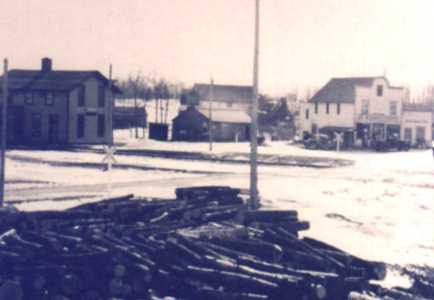


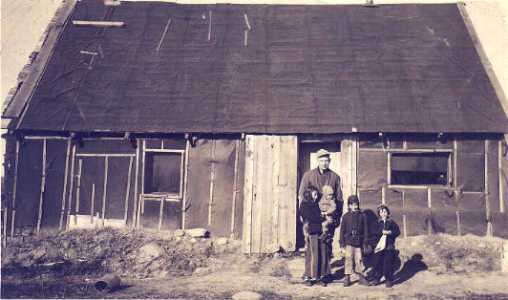

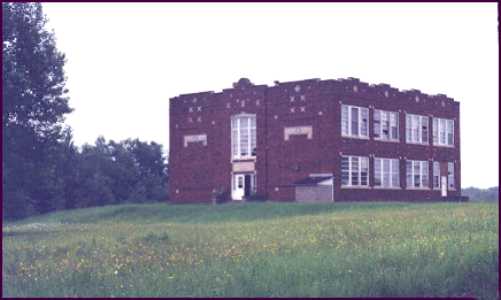



Excerpt from "Beyond the Circle"
by Leo Trunt

